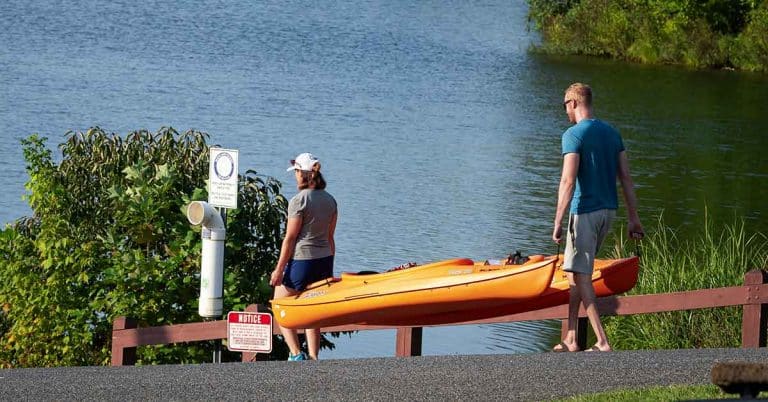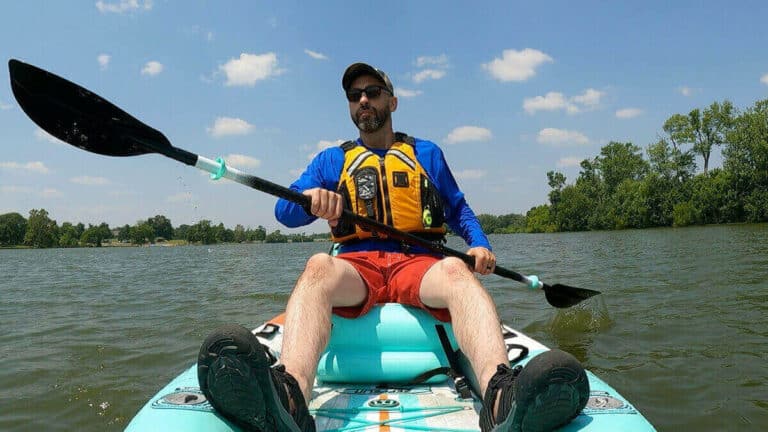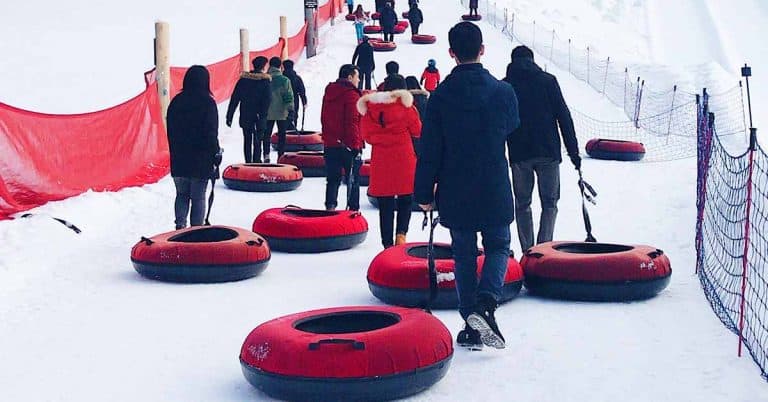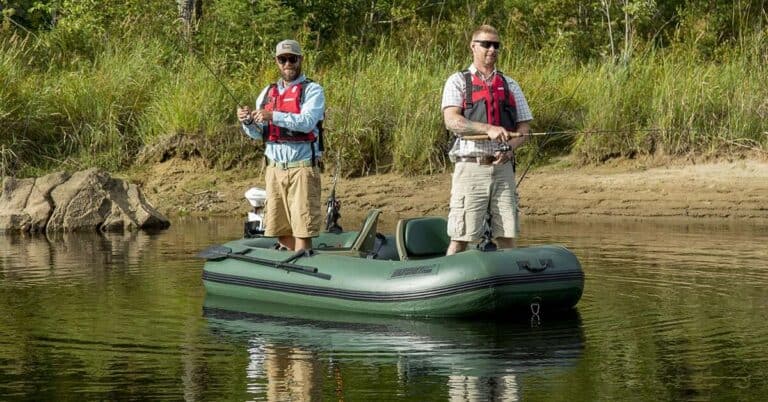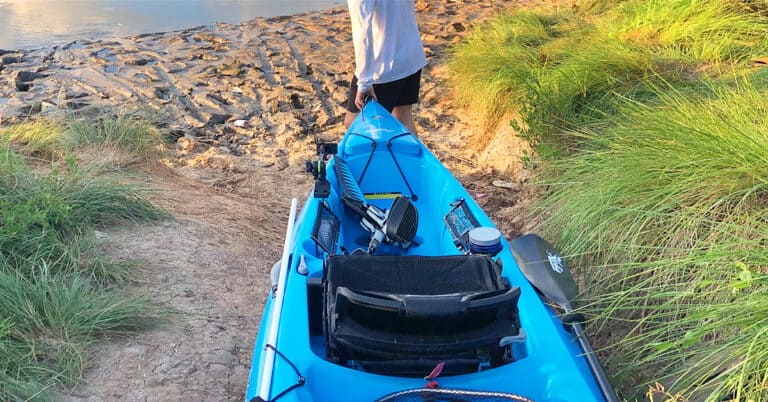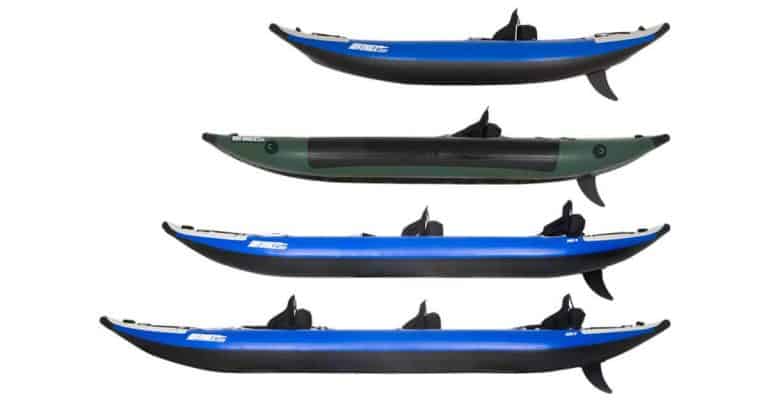Disclosure: I am compensated for purchases made through some links on this site. Click for details.
Are you looking for a kayak that offers the portability and ease of a lightweight model along with durability and performance for adventure? This extensive guide covers everything you need to know about choosing the best lightweight kayak for your needs.
We’ll discuss the benefits of lightweight kayaks, what defines lightness, picking the right one for you, construction materials, key features, safety, maintenance, and more. Let’s get started!
Benefits of Lightweight Kayaks
Why go lightweight in the first place? Here are some of the biggest advantages:
Easier Transport and Storage
Lighter kayaks are much simpler to move around. You can easily carry them from your garage to your vehicle’s roof racks. Unloading or storing them is less physically taxing too. This convenience makes it more feasible to explore different waterways since your boat is portable.
Better Control and Handling
Heavier kayaks can be challenging (at best) or nearly impossible (at worst) to maneuver solo. But lightweight kayaks allow you to steer and navigate more responsive crafts for solo paddling. This added agility also comes in handy when paddling through narrow spaces or tricky terrain.
Increased Speed with Less Effort
Newton’s First Law says that a lighter object requires less force to accelerate. So with less boat to propel forward, you can pick up speed more easily in a lightweight kayak. Less energy exerted per paddle stroke allows you to go faster with high efficiency.
Understanding What Defines a Lightweight Kayak
So what counts as a lightweight kayak? While personal preferences and strength levels vary, most recreational paddlers find the upper weight limit to be around 45 to 55 pounds. This typically includes the full stock setup of a kayak with its seat, foot braces, and thigh pads. Going over 55 pounds starts to hamper many of the handling and transport benefits mentioned above.
A kayak’s weight depends primarily on:
Materials Used: Lighter yet strong materials like carbon fiber and Kevlar composites enable lighter designs.
Design Features: Aspects such as hull shape, air chambers in construction, and compact size can reduce weight.
- Manufacturing Techniques: Methods like vacuum bagging remove excess resin, optimizing lightweight structures.
Factors to Consider When Choosing a Lightweight Kayak
With an idea of why it pays to go lightweight, here are the key elements to factor in while shopping.
Kayak Material
The material used to construct the kayak impacts everything from durability and lifespan to weight and handling. It also affects cost. Here are some top options:
Polyethylene (PE) – This dense, impact-resistant plastic makes up most recreational kayaks. Rotomolded PE crafts offer good rigidity and shape retention at a budget-friendly price point. Weight ranges around 35 to 55 pounds for many one-person models.
Thermoformed PE – A lighter, thinner polyethylene formed through heat and pressure. Kayaks range between 25 to 45 pounds but they sacrifice some stiffness.
Composite Fiberglass – A fiberglass fabric set in epoxy resin. Composite kayaks made this way hit a lightweight yet rigid sweet spot, with prices going up accordingly. Weights a very portable 25 to 40 pounds.
Composite Carbon Fiber – Exotic, lightweight, and ultra-rigid with carbon fiber fabric and epoxy resin. But exotic comes at an exotic luxury price point, usually over $3,500. Weights are an incredible 12 to 30 pounds.
Inflatable Kayaks – Inflatable kayaks utilize durable synthetic fabrics like PVC/Hypalon, Nitrylon, or urethane material sandwiched between durable outer and inner fabrics forms a stiff, paddleable craft when fully inflated. Folded size is compact but inflated size, weight and handling approaches hard shells. Easy transport comes at the cost of performance.
Paddling Style
Factor in what kind of kayaking you plan to use your boat for. Intended use includes variables like water types, solo vs tandem, sit-in vs sit-on-top, and more. Determining whether you’ll use it for recreation, fishing, exercise training, whitewater, or expedition touring guides appropriate features.
Recreational Paddling – For flatwater paddling of lakes and gentle rivers, polyethylene kayaks work well. Fiberglass steps up speed while retaining stability. Wider, shorter kayaks provide initial ease for beginners.
Touring Kayaks – Want to pick up the pace to cover a greater distance? Longer waterline touring kayaks made of fiberglass, carbon, or thermoformed PE help you cruise while packing gear.
Whitewater Kayaking – Maneuverable, specialty whitewater kayaks take on rapids. Made tough, they withstand rock impacts with polyethylene or composite fiber. Expect a heavier setup as a tradeoff.
Fishing Kayaks – Rigged for rods with ample gear storage, fishing kayaks go polythene for affordability and toughness. Lighter than some angling boats, but convenience adds pounds.
Inflatables – The ultimate lightweight when deflated and packed, inflatable crafts appeal for portability but perform less rigidly when pumped up and weighted down with paddler, gear, and water. Great backup boats.
Performance Priorities
The hull’s contours largely determine primary performance. Flatter wider hulls offer initial stability for beginners while narrower more rounded profiles build speed by cutting through water more smoothly. Also consider rocker, length, and tips.
Storage and Transport Needs
If your vehicle cargo space is limited, smaller kayaks in the 10’ range may fit your realities better than 14’ models also consider inflatable or origami-style folding kayak options that deflate or break down into a tiny package compared to hard shells.
Personal Fit and Comfort
Consider your height, torso length, and overall body measurements when test paddling kayaks for a good ergonomic fit. This includes critical dimensions of the seat, cockpit opening, thigh braces, and footrests. Too tight or too loose can quickly lead to discomfort that curtails even short paddling adventures.
Carrying Capacity
Lightweight kayaks allow you to go the distance with less work, but going overboard on loading with heavy gear can swamp that benefit quickly. Verify the load capacity and storage options suit how much kit you need to pack. And don’t forget to factor self-rescue flotation bags, PFDs, and water into the load equation too.
Accessory Options
Today’s lightweight kayaks bristle with accessory options: paddle holders, tie-downs, electronics mounts, rudders, stabilizers, sail kits, pedal drives for hands-free propulsion, and more. But each add-on adorns and weighs down your once lean kayak, so choose carefully.
Gear Storage Capacity
Even sleek fast kayaks need room to stash a few small essentials within reach. Convenience features like built-in waterproof hatches, behind-seat bungees, and deck rigging provide welcome versatility.
Safety Add-Ons
While paddle leashes, helmets, and bilge pumps seem less critical for casual paddling, their importance spikes for remote expedition touring. Spray skirts help seal out water in rougher conditions too.
Manufacturing Methods and Quality Craftsmanship
How meticulously a kayak gets fabricated not only affects durability but also the overall weight. Aspects like resin transfer molding, thermoforming, vacuum bagging, and precise computer-controlled trimming impact the final excellence. Brand reputation serves as your best guide.
Budget Reality Check
As with most gear, cheaper kayaks exist but typically sacrifice something in lower-grade materials, construction techniques, or quality control. Find the price sweet spot balancing quality and affordability for your purposes. Carbon fiber boats cost exponentially more than polyethylene without providing usefulness jumps to justify that for some.
Safety and Proper Maintenance
No matter what type of lightweight kayak you choose, prioritizing safety fundamentals from wearing a PFD to learning proper paddling techniques is key. Additionally, regular maintenance through cleaning after trips, inspections for damage, and proper off-season storage will protect your investment for seasons to come.
Top 7 Best Lightweight Kayaks
Here’s a curated list of some of the best lightweight kayaks spanning materials and usage types:
Dagger Stratos 12.0 Kayak – Best Recreational
- Thermoformed PE construction hits the balance of featherlight yet durable
- Streamlined design weighs just 37 lbs but rides fast, stable
- Adjustable seat, thigh pads, and foot braces dial-in fit
- Sized well for smaller paddlers but works for larger folks too
Oru Inlet Origami Folding Kayak – Most Unique + Portable
- Origami-inspired folding design packs down tiny for storage and transport
- Weighing only 20 lbs, the durable polypropylene hull assembles in minutes
- Wide, stable hull still tracks reasonably straight
- The ultimate backup boat that also works for casual paddling
Eddyline Skylark – Best Touring Kayak
- Sleek fiberglass composite construction keeps weight under 35 lbs
- Hull is optimized for covering distance efficiently with speed
- Impressive rigidity and handling retain a high-end composite feel
- Refined outfitting provides comfort for long hauls
Dagger Mamba 8.6 Whitewater Playboat – Top Whitewater Choice
- High-performance river runner ready to take the hits of rapids
- Made of tough, durable polyethylene but keeps weight moderate at 37 lbs
- Heavily rockered hull and edges grab for spins with precision
- Highly outfitted for control including thigh and knee braces
Vibe Shearwater 125T Tandem Kayak – Best 2-Person Lightweight
- At 57 lbs, it is easily transportable for a tandem that fits two paddlers and gear
- Durable high-density polyethylene hull has a capacity of 500 lbs
- Multiple footrest positions fit different-sized paddling partners
- Rear storage well swallows gear, handles simplify carries
Sea Eagle 330x – Best Inflatable
- Inflatable 33 mil PolyKrylar PVC construction is rugged enough for Class III rapids
- Weighs just 31 lbs deflated but feels solid when fully inflated
- Quickly unpack, inflate, and pack up – great portable spare boat
- Very stable and durable for an inflatable kayak
Check out the Sea Eagle 330x overview.
Sea Eagle 385fta FastTrack Angler – Best Fishing
- Durable rip-resistant 38 mil PolyKrylar hull specially made for fishing
- Generous 500 lb capacity, carry all your gear and catches
- Weighing only 48 lbs, easier to carry than rigid fishing kayaks
- Multiple rod holders, removable seat, abundant accessory options
Check out the Sea Eagle 385fta FastTrack Angler overview.
The Best Light Kayak for You
Choosing the best lightweight kayak means balancing your priorities for performance, features, material qualities, and affordability. Consider when and how you expect to use your kayak most – quick aerobic workouts, meandering marshland tours, or weekend adventure trips packing lots of gear.
Choosing the lightest kayak isn’t always necessarily the right solution if it makes other tradeoffs in hull rigidity, cargo capacity, or durability. But for the little extra effort lightweight kayaks reward you with added agility, speed, and simplicity compared to heavier options, you’ll find more reasons to get out paddling more often.

